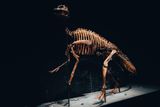Science
New Study Reveals Dinosaur Mummies with Unique Features

A recent study published in Science has unveiled fascinating details about the dinosaur species Edmontosaurus annectens, known for its distinct horse-like hooves and duck-bill. Researchers have discovered that some specimens of this dinosaur, which once roamed the western United States, were preserved in an unusual manner, leading to their classification as “mummies.” This research provides insight into the rare preservation conditions that enveloped these creatures during the Cretaceous period.
The two species of Edmontosaurus, including E. annectens and E. regalis, were among the last dinosaurs to exist before the mass extinction event that occurred approximately 66 million years ago. Known as hadrosaurids, or duck-billed dinosaurs, they had long bills ideal for foraging on vegetation. Fossils of these dinosaurs have been found in various western U.S. states such as Wyoming and Colorado, as well as in Canadian provinces like Saskatchewan and Alberta.
Uncovering the Mummified Specimens
The research focused on two remarkable specimens of E. annectens found in Wyoming: a juvenile around 2 years old and an early adult between 5 to 8 years old. These specimens have been particularly noted for their unique preservation, with their forms outlined in sediment rather than the fossilized bones usually encountered by paleontologists. The mummified remains exhibit features such as skin, spikes, and hooves preserved in a thin clay layer measuring only 1/100th of an inch.
The researchers, led by paleontologist Paul Sereno from the University of Chicago, have designated the area where these specimens were found as the “mummy zone.” They believe the dinosaurs became mummified after their carcasses were enveloped by a flash flood, which subsequently deposited a biofilm that drew clay from the surrounding sediment. Although the original organic material decayed, a three-dimensional template of the dinosaurs remained, encapsulated in the clay.
Revelations About Dinosaur Physiology
Using advanced imaging techniques such as micro-CT scans and X-ray spectroscopy, researchers were able to examine the features of E. annectens in detail. They discovered that these dinosaurs had a fleshy crest running along their necks and trunks, transitioning into spikes down their tails. Their scales were notably small, ranging from 1 to 4 millimeters in size, and the skin appeared thin as indicated by wrinkles along the ribcage.
One of the most surprising findings was the nature of their hooves. The researchers reconstructed the hooves using CT scans and comparisons with duck-billed dinosaur footprints. They noted that the tips of each of the dinosaur’s three hind toes were encased in wedge-shaped hooves with flat bottoms, resembling those of horses. Sereno remarked, “There are so many amazing ‘firsts’ preserved in these duck-billed mummies — the earliest hooves documented in a land vertebrate, the first confirmed hooved reptile, and the first hooved four-legged animal with different forelimb and hindlimb posture.”
This groundbreaking study not only enhances the understanding of Edmontosaurus annectens but also emphasizes the extraordinary conditions that can lead to fossilization. The findings open new avenues for research into the preservation of soft tissues in dinosaurs and contribute to the broader knowledge of prehistoric life on Earth.
-

 Politics1 week ago
Politics1 week agoDallin H. Oaks Assumes Leadership of Latter-day Saints Church
-

 Sports1 week ago
Sports1 week agoSteve Kerr Supports Jonathan Kuminga After Ejection in Preseason Game
-

 Lifestyle1 week ago
Lifestyle1 week agoDua Lipa Celebrates Passing GCSE Spanish During World Tour
-

 Business1 week ago
Business1 week agoTyler Technologies Set to Reveal Q3 2025 Earnings on October 22
-

 Entertainment1 week ago
Entertainment1 week agoZoe Saldana Advocates for James Cameron’s Avatar Documentary
-

 World1 week ago
World1 week agoD’Angelo, Iconic R&B Singer, Dies at 51 After Cancer Battle
-

 Science1 week ago
Science1 week agoChicago’s Viral ‘Rat Hole’ Likely Created by Squirrel, Study Reveals
-

 Lifestyle1 week ago
Lifestyle1 week agoKelsea Ballerini Launches ‘Burn the Baggage’ Candle with Ranger Station
-

 Health1 week ago
Health1 week agoRichard Feldman Urges Ban on Menthol in Cigarettes and Vapes
-

 Health1 week ago
Health1 week agoCommunity Unites for Seventh Annual Mental Health Awareness Walk
-

 Business1 week ago
Business1 week agoMega Millions Jackpot Reaches $600 Million Ahead of Drawings
-

 Business1 week ago
Business1 week agoMLB Qualifying Offer Jumps to $22.02 Million for 2024









